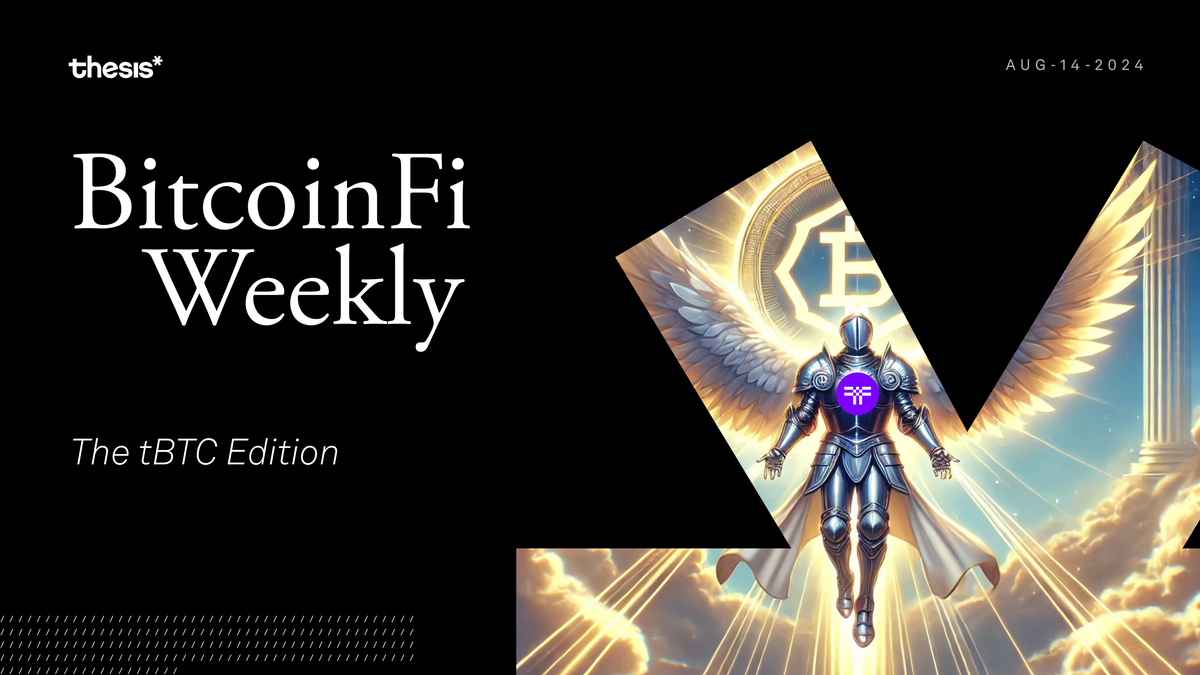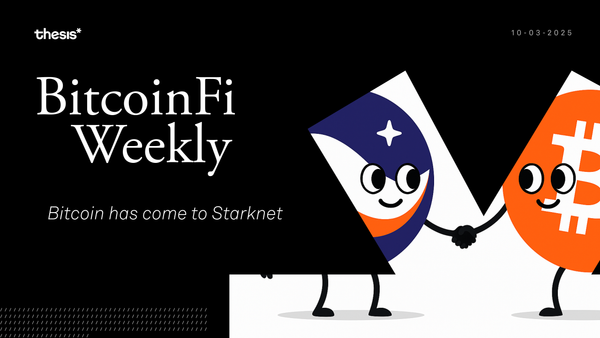The tBTC Edition
Wrapped Bitcoin showed us how easy it is to slip back into old habits, trusting central figures. But tBTC reminds us of what's important. It's not flashy. It doesn't make big promises. It just does what Bitcoin was meant to do.

Welcome to BitcoinFi Weekly. We cover where people use their BTC and what is changing in the Bitcoin world.
Trust shatters like glass, and in its shards, we see our reflection. This week was wrought with controversy, with wBTC laying bare the fragility of centralized systems and tBTC emerging as the knight in shining armor. Meanwhile, demand for blockspace is at an all-time high, yet miners are scraping for revenue. Read on to sift the signal from the noise.
Here’s this week’s rundown:
🩸wBTC’s Fall from Grace and the tBTC Solution
🏧 Solv is Reimagining Bitcoin Reserves
🧠 BitVM2 - the ZK Sequel
💻 Binding Labs Ushers MEV on Bitcoin
Brace yourselves.
Feature Piece: The wBTC Debacle and the tBTC Solution
If time is but a measure of change, then this past weekend seemed an eternity. In the span of a few short days, the very foundations of people’s understanding of tokenized Bitcoin on Ethereum were shaken to their core. For years, Wrapped Bitcoin (wBTC) has held a near monopoly, accounting for over 98% of all Bitcoin represented on the Ethereum blockchain. What started as a simple custody transition for wBTC quickly spiraled into a full-blown controversy, raising doubts about the stability and security of the most widely used Bitcoin wrapper in DeFi.
But before we can examine what just happened, let me take you back to January 2019. wBTC was launched to give dApps on Ethereum access to Bitcoin. Flash forward to August 2024, and the waters surrounding WBTC suddenly got murky. On August 9th, BitGo, the current custodian of wBTC, announced plans to transfer control of the wBTC product to a joint venture with BiT Global. This new partnership will split custody across multiple jurisdictions, including Hong Kong and Singapore. While this change is intended to diversify custody, BitGo has disclosed that the partnership involves Justin Sun—a character who’s as controversial as he is influential.
The reaction from the DeFi and BitcoinFi community was…decisive, to say the least. MakerDAO, one of the most prominent DeFi protocols, is now considering significantly reducing its exposure to WBTC. The proposed changes would see WBTC exposure reduced to zero in its core vaults, WBTC borrowing disabled, and the Loan-to-Value ratio on SparkLend brought down to zero. The risk of this new alliance was summed up by MakerDAO’s monet-supply, who argued that Justin’s track record of opaque management and questionable decisions posed an “unacceptable level of risk” for wBTC.
Trust is a fickle thing. It's like that dive bar you stumble into on the wrong side of town. Looks sketchy as hell, but sometimes it's where you find the best stories, the realest people. But one wrong move, one misplaced faith, and you're stumbling out with an empty wallet and a hell of a headache. Cypherpunks have taken this street wisdom and turned it into a religion, adopting the evergreen mantra: Don't trust, verify.
Lately, though, this mentality has seemingly fallen by the wayside. It seems, for all their lambasting of centralized-this and custodial-that, these same cypherpunks are reactionary — waiting for calamity to strike, then rushing to the podium to yell, “we need to build more decentralized solutions!” It's time we be proactive, putting our principals ahead of our profits.
Enter tBTC
And that's where tBTC comes in. Like a grizzled veteran in that dive bar, tBTC has been around the block a few times. It's seen things, learned from its mistakes, and come out the other side stronger, wiser, and more resilient. Born nearly four years ago, tBTC has been quietly building in the background, evolving from a simple overcollateralized bridge model into a trust-minimized solution with a distributed set of network signers.
The Threshold Network: Powering tBTC's Security
At the heart of tBTC's robust security lies the Threshold Network. Threshold, and its $T token, allow holders to power a one-stop platform for threshold cryptographic services by staking and running a decentralized node. Node operators are crypto-economically incentivized to provide these services without any central authority. Traditionally, critical operations such as signing, randomness generation, and access control require trust in a single entity. However, on the Threshold Network, these functionalities are decentralized and trust-minimized.
Unlike other wrapped Bitcoin solutions, tBTC employs a unique security model that provides several key advantages:
- Forward Security & Probabilistic Signer Selection: For each new wallet, signers are probabilistically chosen. This means that even if malicious actors were to gain control of 51% of the $T stake, they would only have access to new wallets, not existing ones. This "forward security" protects the BTC already bridged through tBTC from hostile takeovers.
- Supermajority Requirements: To truly control the network going forward, an attacker would need a supermajority of the stake. Additionally, if the wallet threshold is raised (e.g., to 60-of-100 signers), it becomes even more difficult for malicious actors to gain control.
- Capital Efficiency: The forward security model allows for more capital-efficient bridging. Theoretically, a signer set with the same $20 worth of staked collateral can secure multiple instances of BTC wallets worth less than $20 each.
- On-chain Proof of Reserves: Unlike wBTC, which relies on periodic attestations, tBTC uses on-chain proof of reserves. This allows anyone to verify the backing of the issued tokens at any time, providing unparalleled transparency.
The events surrounding the BitGo-Sun partnership have underscored the urgent need for decentralized alternatives in the wrapped Bitcoin space. As we stand on the precipice of a new era for Bitcoin, with BitcoinFi promising to bring the world's hardest currency to the masses, tBTC is poised to play a crucial role. This is not some fly-by-night operation, rushing to market with under-engineered bridging models. No, tBTC is a veteran, time-tested, and designed for long-term scaling. The beauty of tBTC lies in its simplicity. It's an easy-to-use, transparent, and secure way to unlock the liquidity of Bitcoin on multiple chains. In fact, tBTC has already been onboarded as collateral for crvUSD and is in the process of onboarding with Aave V3.
Ultimately, it is not the passage of time that defines us; it is the choices we make and the actions we take in the face of adversity. And with tBTC lighting the way, the future of BitcoinFi has never looked brighter.
BitcoinFi Updates
The Solv Solution
SolvBTC is a new project by Solv Protocol aiming to create a "Bitcoin Reserve for Everyone." This initiative comes in response to recent discussions about the ideal Bitcoin standard for DeFi, sparked by changes in WBTC custody.
Key aspects of SolvBTC include:
- 100% backing: Each SolvBTC is backed 1:1 by Bitcoin assets.
- Transparency: A decentralized Liquidity Consensus Network (LCN) allows users to verify Bitcoin reserves at any time.
- Diverse reserve assets: Subject to consensus and governance approval, the reserve will include native Bitcoin, recognized wrapped Bitcoin tokens, and Bitcoin ETFs.
- DeFi integration: SolvBTC offers yield and liquidity opportunities through Bitcoin Liquid Staking Tokens (LSTs) in partnerships with projects like Babylon and Ethena Labs.
The initial reserve assets for SolvBTC are native BTC and BTCB (Bitcoin BEP20). BTCB is a 1:1 BTC-pegged token on the BNB Chain, managed by Binance through a centralized model.
Future plans include expanding the reserve to incorporate other Bitcoin-based assets such as WBTC, BTC.b, M-BTC, FBTC, and decentralized options like tBTC and dlcBTC, pending consensus and governance approval.
BitVM...Part 2?
The implementation of BitVM2 has opened new doors for Zero-Knowledge Proof (ZKP) verification directly on Bitcoin. This approach, detailed in a recent paper, showcases the successful integration of advanced ZKP algorithms like Groth16 and Fflonk within the BitVM2 framework.
The core innovation is the fraud-proof mechanism, which allows efficient ZKP verification without full on-chain execution. The overarching goal: tackling Bitcoin's scalability challenges by reducing the computational load on the network.
Key points include:
- Script Optimization: Certain mathematical tasks can generate large amounts of data in cryptographic operations. For example, operations within the G1 group (a mathematical structure used in cryptography) originally required substantial space—1.7MB for doubling and 3.9MB for addition. Optimization techniques significantly reduced these script sizes, making the operations more efficient and less resource-intensive.
- Script Splitting: To accommodate Bitcoin's 4MB size limit, BitVM2 manually divides large scripts into manageable chunks. This technique was crucial for implementing Groth16 verification, a specific type of zero-knowledge proof system. By breaking down the verification process into 977 smaller subscripts, BitVM2 enables Bitcoin to handle advanced cryptographic proofs despite its transaction size limitations.
- Coordinate Systems: BitVM2 utilizes affine coordinates to enhance security levels and improve efficiency in pairing computations. This coordinate system represents points on a curve using just two numbers (x and y) instead of three. While simpler, it offers performance benefits for certain cryptographic operations, particularly in the advanced pairing computations essential for zero-knowledge proofs.
- Big Integer Multiplication: Implementing the Montgomery reduction and Karatsuba multiplication algorithms in BitVM2 has led to a significant 45% reduction in computation costs. These advanced techniques efficiently handle the very large numbers common in cryptographic operations. Montgomery reduction streamlines modular arithmetic, while Karatsuba multiplication offers a faster method for multiplying large numbers. Together, they substantially speed up the complex mathematical operations that underpin cryptocurrency transactions and proofs.
BitVM2's protocol introduces a new ecosystem of roles and transactions, from stakers to challengers, each playing a part in maintaining system integrity. This structure aims to create a robust, decentralized verification process. Future plans include integrating with Babylon for enhanced BTC slashing capabilities and further optimizing on-chain costs.
Bitcoin’s MEV Era is Nigh
The Bitcoin ecosystem is at a fascinating crossroads. On the one hand, we're seeing unprecedented demand for block space and a congested mempool, driven by innovations like Ordinals and Runes. On the other, miners are grappling with all-time low margins, desperately seeking new revenue streams. This dichotomy presents both challenges and opportunities for the entire Bitcoin community.
However, this increased activity hasn't translated to higher profits for miners. In fact, the hashprice index shows a steep decline in miner profitability, creating a puzzling scenario of high demand but low rewards. MEV has emerged as a potential solution to the mining revenue problem. However, its implementation in the Bitcoin ecosystem is not without issues. The $5 billion Ordinals market is currently struggling with mempool sniping and frontrunning, indicating that existing solutions are falling short.
To address these challenges, Binding Labs is pioneering an innovative solution: a Flashbots-style ecosystem for Bitcoin. This groundbreaking approach includes:
- A private mempool service for superior transaction execution
- Non-canonical block template construction
- Specialized block builders competing in an open market
- Miners focusing on hashing while being compensated through FPPS
Binding Labs' ecosystem aims to give Bitcoin projects access to advanced transaction processing while providing mining pools with standardized MEV revenues. The potential market for Binding Labs' solution is enormous. Conservative estimates put it at $100-250 million today, with projections reaching $10 billion or more in the future.
As BitcoinFi continues to evolve, Binding Labs' solution positions Bitcoin as an ideal data availability layer for rollups and a hub for diverse financial activities.
Closing Thoughts
In the end, it all comes down to trust. Not the blind kind, but the kind you earn. Bitcoin started with a simple idea: no need to trust anyone. Just code. Just math. Now, as the landscape shifts, that idea is being tested. Wrapped Bitcoin showed us how easy it is to slip back into old habits, trusting central figures. But tBTC reminds us of what's important. It's not flashy. It doesn't make big promises. It just does what Bitcoin was meant to do. No single point of failure. No one person in control. Just a network of people, all working together, all keeping each other honest. That's what decentralization means. It's not always easy. But it's true to the spirit of Bitcoin. As we move forward, facing new challenges and opportunities, we'd do well to remember that. Trust, but verify. Always verify. That's the Bitcoin way. That's the tBTC way. And in a world that's always changing, that's something worth holding onto.
Thank you for tuning in to this week’s BitcoinFi Weekly. See you next week.
If there's a topic you’d like us to cover or have questions, reach out at [email protected].
Learn more about Mezo at the following channels:
👾 Discord: https://discord.mezo.org
🕊 X: https://twitter.com/MezoNetwork
🖥 Website: https://mezo.org
🏦 Deposit Portal: https://mezo.org/hodl
ℹ️ Docs: https://info.mezo.org





